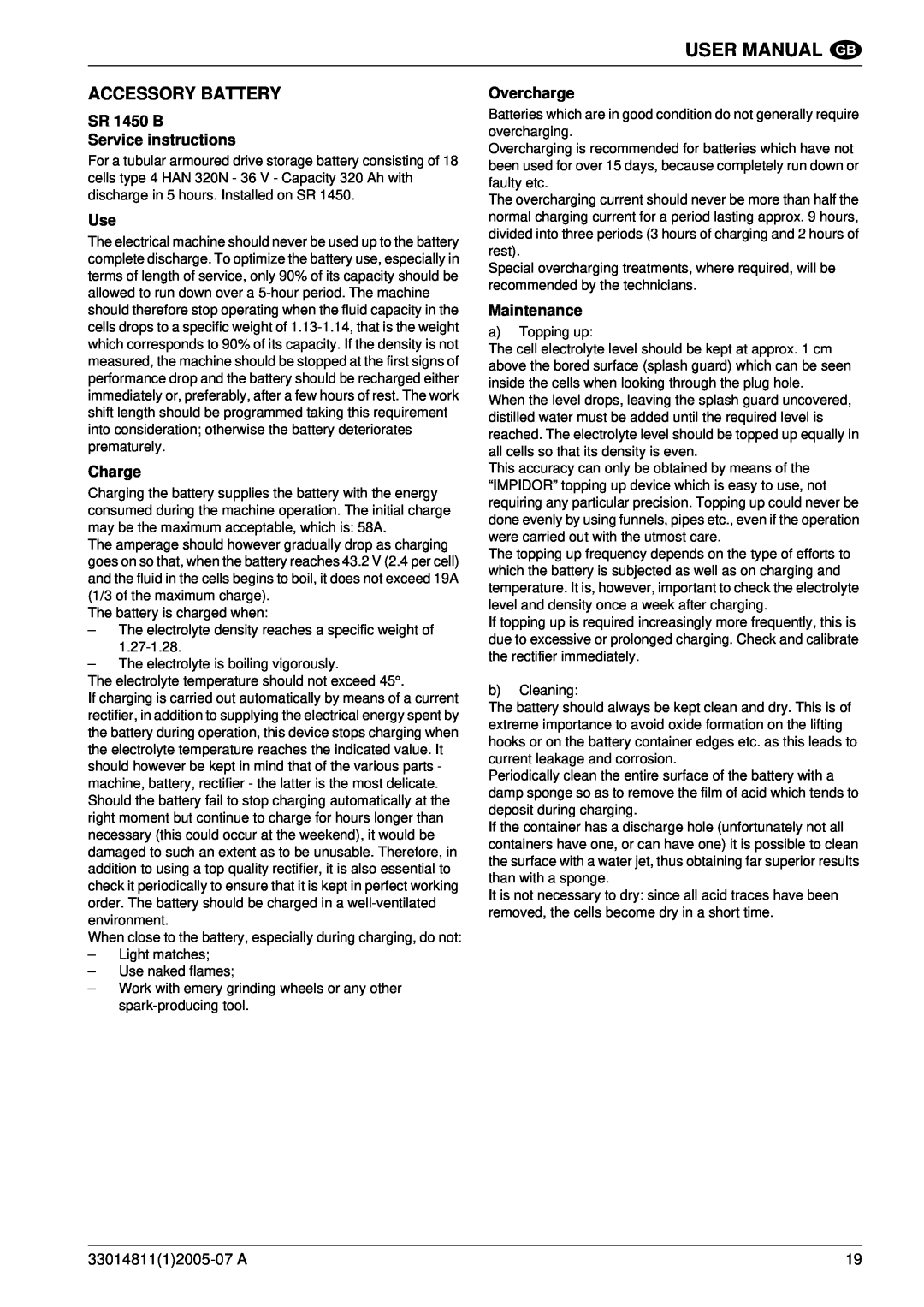
USER MANUAL ![]()
ACCESSORY BATTERY
SR 1450 B
Service instructions
For a tubular armoured drive storage battery consisting of 18 cells type 4 HAN 320N - 36 V - Capacity 320 Ah with discharge in 5 hours. Installed on SR 1450.
Use
The electrical machine should never be used up to the battery complete discharge. To optimize the battery use, especially in terms of length of service, only 90% of its capacity should be allowed to run down over a
Charge
Charging the battery supplies the battery with the energy consumed during the machine operation. The initial charge may be the maximum acceptable, which is: 58A.
The amperage should however gradually drop as charging goes on so that, when the battery reaches 43.2 V (2.4 per cell) and the fluid in the cells begins to boil, it does not exceed 19A (1/3 of the maximum charge).
The battery is charged when:
–The electrolyte density reaches a specific weight of
–The electrolyte is boiling vigorously.
The electrolyte temperature should not exceed 45°.
If charging is carried out automatically by means of a current rectifier, in addition to supplying the electrical energy spent by the battery during operation, this device stops charging when the electrolyte temperature reaches the indicated value. It should however be kept in mind that of the various parts - machine, battery, rectifier - the latter is the most delicate. Should the battery fail to stop charging automatically at the right moment but continue to charge for hours longer than necessary (this could occur at the weekend), it would be damaged to such an extent as to be unusable. Therefore, in addition to using a top quality rectifier, it is also essential to check it periodically to ensure that it is kept in perfect working order. The battery should be charged in a
When close to the battery, especially during charging, do not:
–Light matches;
–Use naked flames;
–Work with emery grinding wheels or any other
Overcharge
Batteries which are in good condition do not generally require overcharging.
Overcharging is recommended for batteries which have not been used for over 15 days, because completely run down or faulty etc.
The overcharging current should never be more than half the normal charging current for a period lasting approx. 9 hours, divided into three periods (3 hours of charging and 2 hours of rest).
Special overcharging treatments, where required, will be recommended by the technicians.
Maintenance
a)Topping up:
The cell electrolyte level should be kept at approx. 1 cm above the bored surface (splash guard) which can be seen inside the cells when looking through the plug hole.
When the level drops, leaving the splash guard uncovered, distilled water must be added until the required level is reached. The electrolyte level should be topped up equally in all cells so that its density is even.
This accuracy can only be obtained by means of the “IMPIDOR” topping up device which is easy to use, not requiring any particular precision. Topping up could never be done evenly by using funnels, pipes etc., even if the operation were carried out with the utmost care.
The topping up frequency depends on the type of efforts to which the battery is subjected as well as on charging and temperature. It is, however, important to check the electrolyte level and density once a week after charging.
If topping up is required increasingly more frequently, this is due to excessive or prolonged charging. Check and calibrate the rectifier immediately.
b)Cleaning:
The battery should always be kept clean and dry. This is of extreme importance to avoid oxide formation on the lifting hooks or on the battery container edges etc. as this leads to current leakage and corrosion.
Periodically clean the entire surface of the battery with a damp sponge so as to remove the film of acid which tends to deposit during charging.
If the container has a discharge hole (unfortunately not all containers have one, or can have one) it is possible to clean the surface with a water jet, thus obtaining far superior results than with a sponge.
It is not necessary to dry: since all acid traces have been removed, the cells become dry in a short time.
19 |
